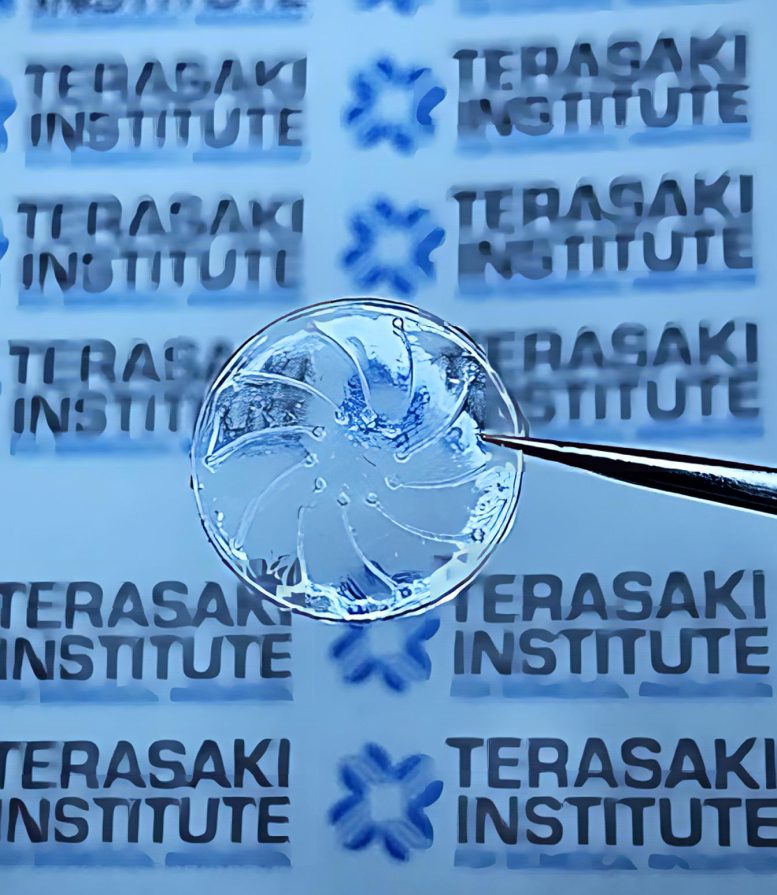
Los científicos tienen un prototipo de lente de contacto diseñado específicamente para prevenir la sequedad ocular inducida por lentes de contacto. Crédito: Instituto Terasaki para la Innovación Biomédica
Un equipo del Instituto Terasaki para la Innovación Biomédica (TIBI) ha creado un prototipo de lente de contacto destinado a combatir la sequedad ocular inducida por lentes de contacto (CLIDE). Este innovador diseño de lentes ayuda a aliviar CLIDE al promover el flujo de lágrimas a través del parpadeo normal de los ojos. Este desarrollo tiene el potencial de aliviar la incomodidad, los problemas de visión y los riesgos de inflamación que enfrentan los millones de usuarios de lentes de contacto que sufren CLIDE.
De los 140 millones de personas en todo el mundo que usan lentes de contacto, entre el 30 % y el 50 % experimenta CLIDE. CLIDE es causado por un flujo insuficiente de lágrimas desde la superficie externa de la lente de contacto hacia la superficie interna, lo que conduce a una evaporación excesiva de lágrimas y los síntomas asociados de CLIDE.
Los tratamientos actuales para esta afección incluyen volver a humedecer las gotas para los ojos, los geles o los lubricantes, el reemplazo frecuente de los lentes o cambios en el material de los lentes. También hay tratamientos para los párpados, como masajes en los párpados y compresas calientes. En casos más severos, se puede utilizar la estimulación física de las glándulas lagrimales, así como el uso de tapones lagrimales, que son dispositivos que se insertan en los conductos lagrimales para evitar el drenaje. La eficacia varía entre estas terapias, sin embargo, también puede haber acumulaciones de medicamentos potencialmente dañinas en el cuerpo, y los métodos que no son fáciles de usar contribuyen al incumplimiento del paciente.
También ha habido intentos previos de usar lentes de contacto en el tratamiento del síndrome del ojo seco, como[{» attribute=»»>graphene-coated lenses designed to minimize moisture loss and self-moisturizing lenses stimulated with metallic electrodes. But these methods are costly and impractical and may compromise patient safety and comfort.
The TIBI team’s approach uses a contact lens design that incorporates microchannels to facilitate tear flow movement and flow so that dry eye can be avoided. This flow can be achieved by pressure applied by normal eye blinking so that no external devices are needed.
In fabricating their contact lens prototype, the team utilized a time-saving method – their lens mold was made from a silicone polymer mixture; this allowed for easy removal of the lens cast on it by gently bending the mold. Previous methods necessitated a twelve-hour soak in hot water to remove the lens. The approach resulted in high-quality, smooth microchannels, as well as lenses that could be thirty times thinner than previous lenses. A custom device was used to fabricate reservoirs at the ends of each microchannel for the inflow and outflow of liquids.
Innovative techniques were also utilized when encapsulating the microchannels in a sandwich-like assembly under a capping lens layer. Initially, the preparation of the two lens surfaces for stronger bonding dehydrated the lenses, causing them to curl. This problem was solved by affixing the two lenses to holders using water-soluble glue. This served not only to enable a more uniform bonding of the lenses but protected them from damage as well.
After rigorously testing their encapsulated microchannel lenses for stability and leakage, the lenses were subjected to a series of experiments using a device that the team designed to simulate a blinking eyelid. This device was integrated with the lens prototype to create artificial eyelid pressure on the lens to stimulate tear flow.
After various experiments, a configuration that proved effective was microchannels with square cross-sections arrayed in a novel circular pattern on the lens surface; this was compatible with the function and curvature of the lens and allowed for optimum liquid flow.
The team demonstrated a proof-of-concept validation of their lens’ ability to guide tear flow originating from the lens surface to the underside of the lens to combat dry eye syndrome. The team quantified these flows and established that the flows were driven by low-pressure levels like those from normal eye blinking. Further experiments could be devised to test these lenses on animal models and in patients.
“The inventive methods that our team has employed bring a potential solution for millions of people,” said Ali Khademhosseini, TIBI’s Director and CEO. “It is the hope that we may extend our efforts to bring this solution to fruition.”
Reference: “A Microfluidic Contact Lens to Address Contact Lens-Induced Dry Eye” by Yangzhi Zhu, Rohollah Nasiri, Elham Davoodi, Shiming Zhang, Sourav Saha, Matthew Linn, Lu Jiang, Reihaneh Haghniaz, Martin C. Hartel, Vadim Jucaud, Mehmet R. Dokmeci, Anna Herland, Ehsan Toyserkani and Ali Khademhosseini, 23 December 2022, Small.
DOI: 10.1002/smll.202207017
The study was funded by Cooper Vision, Inc.

«Erudito en viajes incurable. Pensador. Nerd zombi certificado. Pionero de la televisión extrema. Explorador general. Webaholic».







